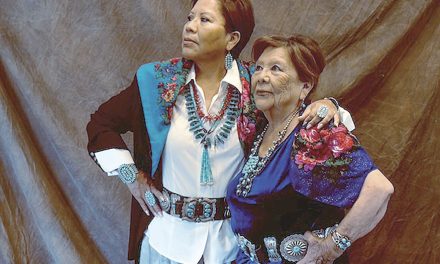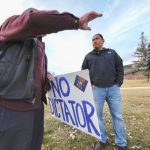
‘Low-level’ uranium waste to be disposed near Dlǫ́’áyázhí
THOREAU, N.M– To clean up uranium mine waste, the U.S. Environmental Protection Agency offers solutions that, as far as Diné are concerned, aren’t solutions.
The EPA is considering four disposal options for a mine waste cleanup but is leaning toward two specific options based on cost and time considerations.
The uranium mine waste cleanup options are for Quivira and Section 32 and 33 uranium mine sites. The sites are in Eastern Navajo: Coyote Canyon, Standing Rock, Pinedale, and Casamero Lake chapter boundaries.
The four options being considered by the EPA are:
1. Take no action,
2. Consolidate and cap waste on site,
3. Remove waste and dispose of it in a new disposal area or
4. Remove waste to an existing disposal facility.
Joshua Alexander, a press officer for EPA Region 9 (Pacific Southwest), said in a December email that the EPA will not go with option one, taking no action, and is less likely to go with option four because it is prohibitively expensive ($556.2 million), and would take longer to transport the waste, as the existing disposal site is over 500 miles north in Colorado.
‘Disposal locations’
But options two and three are “looking promising,” said Alexander.
Option two, consolidating and capping the waste at the mine sites, calls for a reconfiguration of the trash so that there’s long-term stability to maintain the waste.
Option three, removing waste to a newly created disposal site, calls for the waste to be transported 44 miles to the Red Rocks landfill in Thoreau, off the Navajo Nation, and disposed of in a new state-permitted disposal cell.
According to Alexander, “The Navajo Nation government and the Red Water Pond Road Community Association requested that EPA look into disposal locations for uranium mine waste off the Navajo Nation.”
Both the EPA and Navajo EPA found the Red Rock landfill as a viable option for disposal as it is off the Nation, per the Navajo Nation’s and community’s request.
Option two would cost $66 million, option three would cost $182.2 million, according to Alexander, and the Tronox Settlement would incur the cost.
The Tronox Settlement is a bankruptcy settlement from 2011. They owed $270 million and 88% of their interest from a fraudulent conveyance case to the Navajo Nation and other federal, state, and local entities to clean up sites contaminated by uranium mining.
What can’t be covered by the settlement will be handled by an existing responsible party, Rio Algom Minerals LLC.
From Dec. 12-13, U.S. EPA and Navajo EPA went to the Baca/Prewitt and Thoreau chapter houses and the McKinley County Senior Program facility in Thoreau to inform community members of the area’s disposal options for uranium mine waste.
Prominent concerns run deep
At the three open house meetings that took place, Alexander heard six prominent concerns from the community:
Exposure to the waste from transportation through the community, Possible vehicle accidents causing exposure,
Long-term risks to the other community if relocated there,
Groundwater contamination from the mine and disposal site,
Air contamination from wind, and Animal grazing on or near the waste disposal site.
Regarding the concerns about disposal options, Alexander said, “This is not uranium waste. This is mine waste with deficient levels of naturally occurring uranium and other radionuclides (radioactive forms of elements).”
However, the concern runs decades deep for Diné.
Steven Arviso, the Council delegate for Thoreau, remembers hearing about the disposal options near Thoreau last June and believes that the uranium mine waste should be taken from Mariano Lake and surrounding communities. Still, he also doesn’t want it near Thoreau.
“It’s a long-time effect that not many people will understand unless they live it,” said Arviso.
Arviso resides in Iyanbito, 20 miles west of Thoreau, near the disposal mining sites. He understands there are consequences to both uranium mining and its disposal.
Disposal transportation can leave remnants flying elsewhere, which could end up in water sources that the community uses.
“What we don’t want to see happen is putting it in our neighboring chapter’s yard. That just doesn’t make sense to a lot of people,” said Arviso. “If you’re going to remove it, why just take it a few miles? Why not take it farther from the Navajo Nation?”
Thoreau Chapter community members had expressed to Arviso that they don’t want the mine waste disposal near them.
Arviso was surprised he hadn’t heard about the disposal options near Thoreau before June alongside his fellow Eastern Agency Council delegates.
According to Arviso, Council delegates Seth Damon, Norman M. Begay, and Speaker Crystalyne Curley were in attendance. Arviso believes Delegate Lomardo Aseret also attended the Eastern Agency meeting in Baca, New Mexico.
Lack of information
Arviso witnessed a lack of information being shared with Diné in English and Diné Bizaad. That information is vital for the communities he represents because it’s their home the EPA is potentially disrupting with mining and disposal options.
Mining began in the Navajo Nation in 1944 under leases with the Navajo Nation. Those leases later appeared to be a grave mistake, with health declining for Diné, who lived near and around mining sites.
According to the National Institute of Health, lung cancer is the most significant health concern when dealing with uranium mining.
While the disposal option is off the Nation and is ultimately up to New Mexico Gov. Michelle Lujan Grisham, Arviso believes the Navajo Nation should have a say.
In response to Alexander’s statement on the mine waste not being a concern because it’s “low-level,” Leona Morgan, 42, a Diné organizer for “Haul No!,” from Fort Defiance, said, “Any trace of uranium is a concern.”
Haul No! is an Indigenous-led organization that spreads awareness on uranium mining and milling, transport of radioactive materials, and cleanup of abandoned uranium mines in the southwest.
Cleanup ‘can’ happen
“The U.S. EPA is acting as an oppressive force dictating to us what our future will be. This is not public input. This is not civil participation.”
Similar to Arviso, Morgan believes an actual cleanup can only happen if Diné is behind the process and if it’s understood by Diné, not the Navajo Nation government, not Navajo EPA, but the Diné who are living in the surrounding areas of mine sites–the farmers, elders, and children.
Morgan recounts the Red Water Pond Uranium cleanup, where former Navajo EPA assistant director Dariel Yazzie vocalized his concerns about the U.S. EPA’s treatment of the Navajo Nation government and its lack of listening and commitment.
Families impacted by the uranium mine spill wanted to relocate for health and safety concerns, but the EPA did not take action because of cost.
With the disposal options for the Quivira and Section 32 and 33 mines, Morgan sees a lack of listening from the U.S. EPA.
“To me, for them to bring these four options is a slap in the face to all these people who have come to all these meetings over the years,” said Morgan, “and they’re demanding cleanup.”
At the previous meetings Morgan attended regarding the Red Water Pond Uranium spill, the community members wanted a holistic cleanup that went deeper than just removing the contaminated areas.
Morgan remembers Yazzie telling the EPA at one of the meetings that the process should start with prayer and the way Diné do things, considering every living being: humans, plants, animals, and even rocks.
“A huge part of the cleanup is not messing it up again,” said Morgan.
The proposed disposal option in Thoreau is one of 230 other cleanup projects in the Navajo Nation as of September, according to the EPA website.
“The cleanups need to be considered together, cumulatively,” said Morgan.
Morgan wants the community to be involved with the research so they know the levels and what it looks like instead of being told it’s “low-level.”
“Navajo Nation, we have such a big mess that we can’t be taking these little band-aid solutions the government is forcing on us,” said Morgan. “The status quo for cleanup needs to be changed.”








 Highway 264,
Highway 264, I-40, WB @ Winslow
I-40, WB @ Winslow